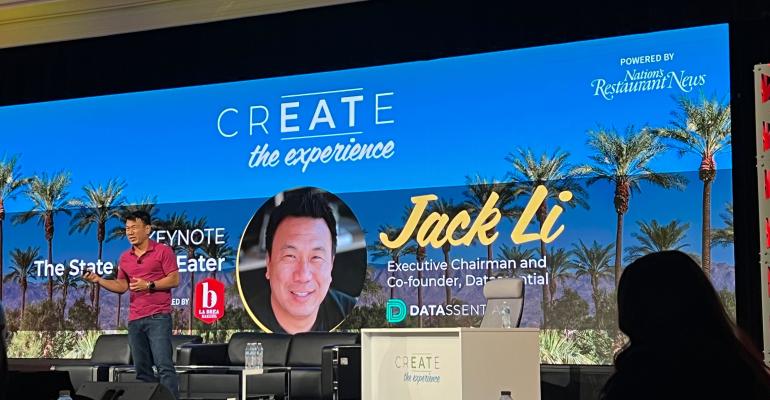As the world recovers from the pandemic, restaurateurs need to respond to new customer perspectives, including a desire for food that is distinctive and craveable enough for them to part with their hard-earned money and, increasingly, that also is good for them.
That was the conclusion that Jack Li, executive chairman and co-founder of Datassential, shared with attendees of CREATE: The Experience, at the Margaritaville Resort in Palm Springs, Calif., on Monday.
In his keynote address on “The State of the Eater,” Li reflected on a foodservice landscape that has been transformed. According to data from Li’s market research firm, there are now around 25,000 fewer restaurants in the United States than there were at the beginning of 2020, and their menus are less distinctive than they had been in the past, as far as consumers are concerned.
He said that in surveying people about new menu items, those that had been introduced since 2021 tended to score lower in terms of differentiation from other items than the ones introduced before the start of the pandemic.
“There’s maybe been a little bit of playing it safe on the menu, to not bring in the really interesting flavor or dish or flavor combination in flavor of something that seemed like more of a mainstream hit for the audience,” Li said.
He added that, although that might be sensible in the short term, “I think it’s sort of fatal in the long run … because we will lose one of the key reasons why people want to get food from restaurants in the first place, which is to try something new.”
To make matters worse, consumers that Datassential surveyed said that, as inflationary pressures cut into their discretionary income, they had cut back more on eating in restaurants than any other segment.
Those consumers said food eaten at home was more affordable and healthier: 86% said eating at home was more affordable than restaurants and 89% said food at home was more healthful.
Even in terms of convenience, only 51% ranked restaurants eating at home. Li said that relatively low score had to do with the fact that more people were working from home, meaning going out for a meal was less convenient than it had been in the past.
Where restaurants perform well is in craveability, which 65% of consumers preferred over what they ate at home. In fact, he said the typical consumer is more excited about eating leftover restaurant food than what they make at home.
Additionally 63% of consumers said eating in restaurants was more enjoyable.
“We really want to make sure that we lean into our strengths,” Li said, and that meant serving craveable food in an enjoyable setting.
He said now that the industry is recovering from the pandemic, the new restaurants that are opening are responding to guests’ interest in going out for differentiated food and better experience, leaning into what restaurants are best at.
“Now we’re seeing new restaurants opening up that are a bit more inventive in what they do and the types of food that they serve. I think we’ll see a really nice wave of culinary creativity in this next generation of restaurants,” Li said.
“Creativity is what’s going to drive this industry forward, certainly,” he added.
But he also challenged the restaurant operators in the audience to do better at making healthy food more craveable.
He pointed to data indicating that, although average life expectancy of Americans had been increasing for the past 100 years, with the exception of a precipitous drop during the Spanish Flu pandemic of 1918-1919, it had stopped rising even before the 2020 pandemic and might possibly be decreasing now.
Li asked the artificial intelligence-driven tool ChatGPT, based on the data it had, what were the likely leading causes of that decline. It put the opioid addiction epidemic at the top, but that was followed by unhealthy diets and rising obesity rates.
He showed the audience the continuous blood-glucose monitoring device that he wore, and pointed to other tools, such as continuous monitors of blood pressure and other heart functions, as equipment that a growing number of Americans use, making them more aware of their health issues.
He said that providing food that is simultaneously healthful and craveable is an unmet consumer need. Pointing to data indicating that even when customers go out intending to eat healthfully the majority end up ordering something they don’t perceive as healthful.
He said that the top reason why people don’t eat healthfully when they eat out is because it’s an occasion to indulge, which is fine, but the second most frequent reason is because there aren’t enough healthful options.
“There is a big opportunity to fix this and make some real money in doing it.”
According to Datassential’s and Nation’s Restaurant News’ survey of the Top 500 largest restaurant, the fastest growing, by far, in terms of sales are limited-service healthful restaurants.
“We have strong empirical that consumers are voting with their pocketbooks for something that’s healthier,” he said
He concluded by giving attendees a homework assignment to think about what they can do to make healthy food more enticing.
“I think all of our interests align if we’re willing to tackle this one thing.”
Contact Bret Thorn at [email protected]

